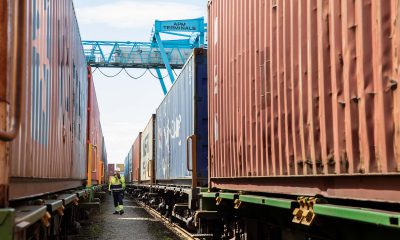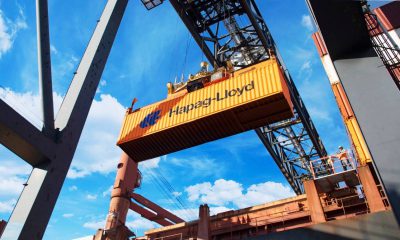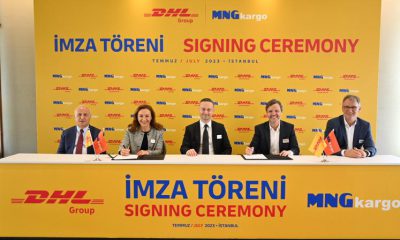As one of the largest global transport and logistics companies, DSV wants to take the lead and be a key driver of the green transition in the industry. To follow up on the commitment to the Science Based Targets initiative and the targets approved in 2020, DSV is launching Green Logistics – a highly ambitious set of green offerings within the industry focusing on reducing emissions for DSV’s customers. The Green Logistics solutions will be available for companies of all sizes globally and across all major transportation modes.
The need for concrete climate actions has never been more evident and more important than today. With increasing global trade and freight transport making up a weighty part of global CO2 emissions, the transport and logistics industry must look at how its transportation activities are conducted, and it must carry out tangible initiatives to make them more sustainable.
Green Logistics is DSV’s new set of customer offerings aiming at accelerating the green transition in the global supply chains. With four tailored solutions ranging from CO2 reporting, green supply chain design & optimisation to sustainable fuel offerings across all transportation modes and carbon offsetting, DSV wants to help customers reduce their CO2 emissions from transportation without restraining their businesses.
The focus of Green Logistics is on addressing our customers’ CO2 emissions and thereby also DSV’s emissions from subcontracted freight. In parallel with the introduction of Green Logistics, DSV is underlining our commitment to take on the responsibility to drive the industry towards a greener future where world trade is conducted with consideration to preserve our nature.
“DSV is determined to support the green transition of our industry. As the world’s third-largest transport and logistics company, we take our responsibility seriously. We are ready to act together with all our partners and customers so that we can reduce CO2 emissions and mitigate the negative impact of climate change. By providing our customers with our new Green Logistics offerings, we are going to analyse and advise our customers to rethink their supply chains and enable them to conduct their business in a more sustainable way,” says Jens Bjørn Andersen, Group CEO, DSV.
From sustainable commitment to sustainable actions
In 2020, DSV set approved Science Based Targets (SBT) with ambitious targets for greenhouse gas reductions across scope 1, 2 and 3 by 2030 from a 2019 baseline. More than 98 percent of the CO2 emissions registered by DSV are generated as scope 3 emissions compiled by all types of subcontracted freight.
This is where the Green Logistics solutions come into play:
“With Green Logistics, DSV is taking a significant leap from commitment to action. Today, we bring forward four solutions that will enable us to keep supply chains flowing in a more sustainable way and with respect for our nature. But we can only move the sector and cut down CO2 emissions if we have our customers’ engagement and a collaborative approach. We must act together,” says Jens Bjørn Andersen.
Four Green Logistics solutions for all types of transportation
The Green Logistics solutions will be applicable for all major transportation modes across all markets. With Green Logistics, DSV is providing a one-stop shop for green transport and logistics solutions.
The four solutions are:
- CO2 Reporting – Track and trace your impact: Gives the customer insight and full overview of CO2 emissions to help drive transport emission reductions.
- Green Supply Chain Design & Optimisation – Rethink your Logistics: Concrete and individual analyses that streamline the customer’s supply chain and identify the largest CO2 emission reductions across the supply chain.
- Sustainable Fuel Offerings – Fuel your green transition: Allows the customer to choose sustainable alternative fuels across major modes of transport to reduce CO2 emissions without changing operations.
- Carbon offsetting – Compensate your carbon footprint: This allows the customer to finance sustainable projects that compensate for their carbon footprint.
If you are interested in learning more about Green Logistics and the four solutions, please visit DSV.com.
DSV’s commitment to the Science Based Targets initiative
In 2020, DSV announced ambitious targets approved by the Science Based Targets initiative for reducing the company’s CO2 emissions.
By 2030, DSV has committed to reducing scope 1 and 2 emissions (e.g. from company cars, offices and warehouses) by 40% and scope 3 emissions (primarily from subcontracted freight transport) by 30% from a 2019 baseline.
Explanatory customer cases
Short explanatory cases describing realistic customer scenarios for the different products.
Case 1: Green Supply Chain Design & Optimisation:
The customer has little idea of where to start with CO2 emission reduction. DSV can help conduct an emission hotspot analysis for the customer to identify the highest emitting lanes both for air, sea and road freight. Then, using DSV’s differentiated and unique offering – green procurement carrier analysis – DSV’s team of experts can conduct a detailed evaluation of potential carriers on the identified lanes. The next step is to find the least emitting carriers and help the customer incorporate CO2 emission intensity as an important element in choosing carriers, along with other business considerations such as cost and time.
Case 2: CO2 reporting
The customer has no overview of the CO2 emissions from the transport. DSV can help provide a detailed overview of emissions from different modes and divided by the legs of transport. This can form a good basis for the customer to understand emissions from transportation and then work with DSV on initiatives to reduce these specific emissions.
Case 3: Sustainable fuel offerings
The customer is a high-end fashion & retail customer who has a dependence on using air freight as a mode of transport for final goods in order to stay relevant with the fashion trends. DSV helps the customer reduce CO2 emissions from a high emission air freight lane using sustainable aviation fuel and without making any changes to the customer’s operations.
Case 4: Carbon offsetting
DSV’s Carbon Offsetting offering allows a customer to invest in environmental projects to compensate for their CO2 emissions. One project may be the construction of a wind or solar farm that reduces reliance on fossil fuels, another may be planting trees to extract CO2 from the atmosphere. Customers can decide to reduce any proportion of their emissions by investing in the chosen project and claiming credits.
























